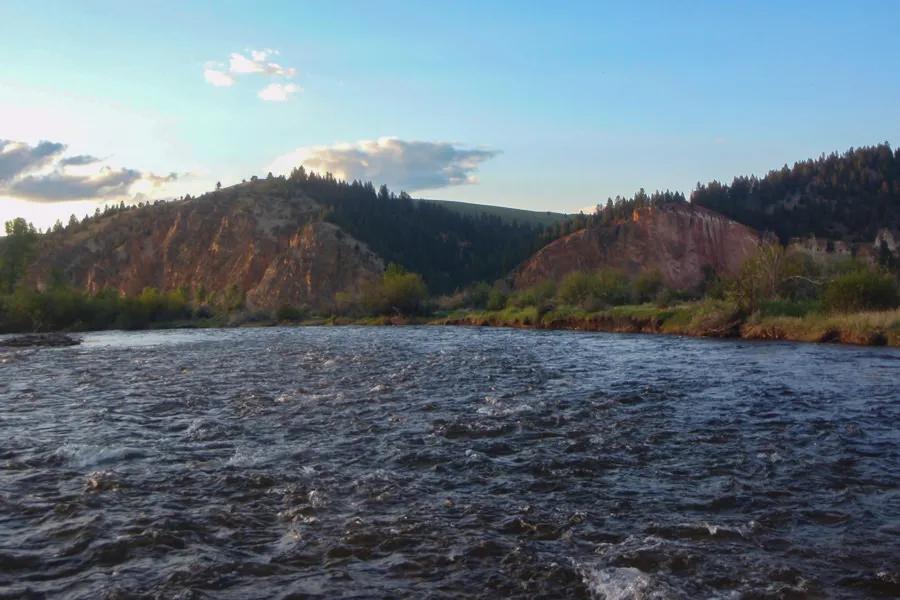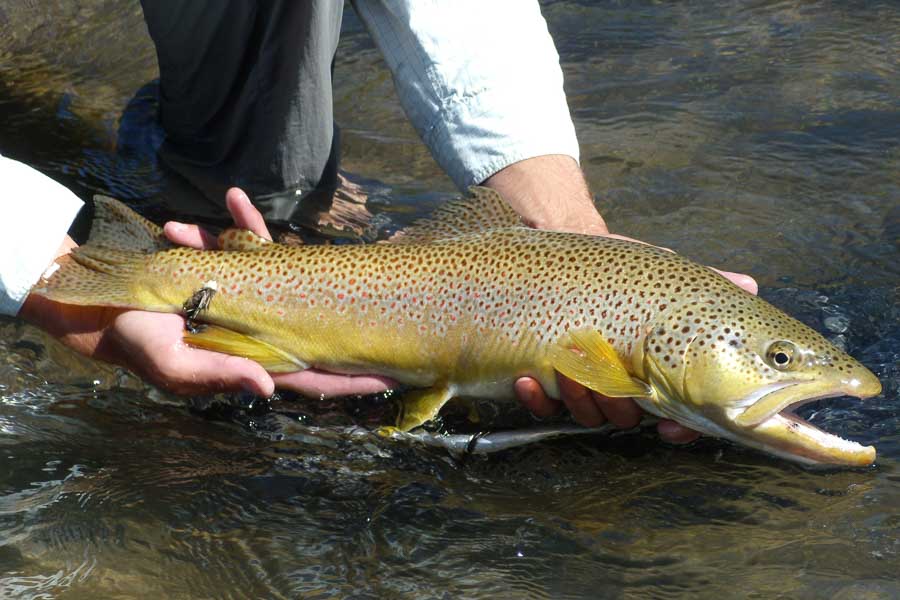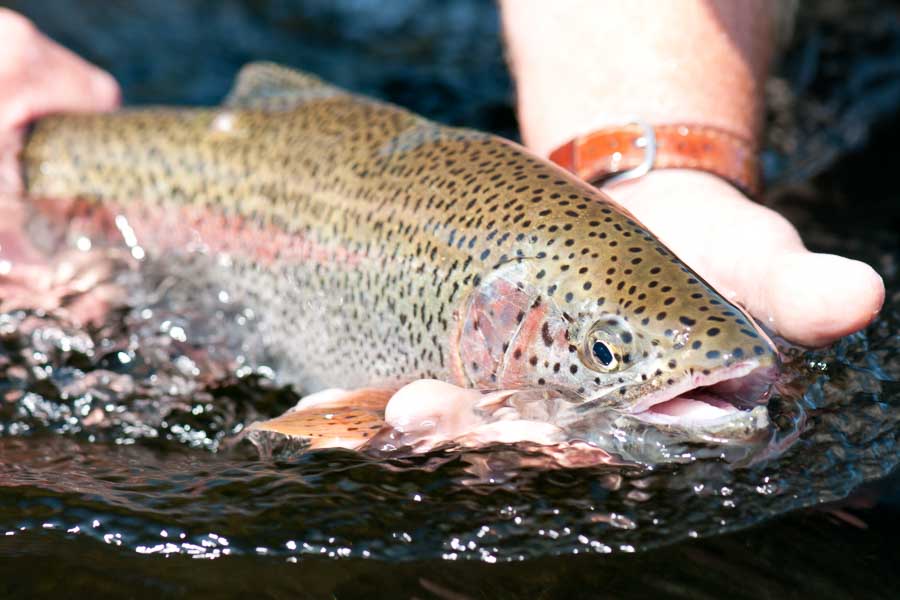Rock Creek is probably the most famous creek in western Montana. It is a 20-minute drive from Missoula, traveling east on Interstate 90. It is included in the River section, as it is floatable in the spring and into early summer.
Rock Creek By Mark E. Jones
Allow your mind to conjure up a classic, free flowing trout stream located in the Rocky Mountains of western Montana, and you will have created a mental image of Rock Creek. Rock Creek is located approximately 25 miles east of Missoula, Montana where, after flowing through fifty miles of mostly national forest service lands, it enters the Clark Fork River. It remains one of the true "Blue Ribbon" fisheries of the West, supporting large populations of browns and cutthroats.
Rock Creek is a mostly free flowing, classic Western trout water. Although Rock Creek is open year around, and provides some excellent angling opportunities before high water, the fishing season typically commences with the salmon fly hatch in late May or early June.
The salmon fly hatch on Rock Creek is somewhat more predictable than many Western rivers, and the angler arriving on the creek during the second or third week of June will have the opportunity to present large salmon fly imitations (size, 2,4 or 6) to hungry fish. Because of the high water, the same angler will also encounter difficult wading conditions and may find themselves competing for the relatively few wadable areas with other bank anglers. However, if you are a strong wader and not opposed to a day of slipping and sliding, June fishing on Rock Creek can be productive. During these high flows, fishing from a well equipped raft is far more productive. This success is attributable to the float fishing angler's ability to access all available holding water with long, drag free floats. Commerical outfitters and private floating is permitted until July 1, at which time all fishing from boats is prohibited.
As June gives way to July and August, Rock Creek quickly recedes and becomes more "wader friendly." The boats are gone, and at this time one can expect to encounter large golden stone flies intermingled with assorted mayflies and caddis. The hectic pace of fishing the salmon fly hatch quiets and gives way to the more typical attempt to match the hatch. Rock Creek trout are easily fooled, and the lower water defines the obvious holding water.
A few special words are required about the spruce moth fishing in August. Generally, in early August, Rock Creek provides some incredible morning fishing to the angler using any reasonable light colored, down-winged imitation. Any size 12 elk hair caddis will do. Depending on the day, the fishing will commence early and continue until 10:30 or 11:00 am. Then, the bugs simply disappear and the fish take up their more subtle forms of feeding.
Fishing in September and October on Rock Creek is not as predictable as in the early summer months. For whatever reason, Rock Creek trout become more selective and difficult to catch. This is not to say that one cannot expect outstanding fishing, but only that the fall fishing does not match the incredible catch rate of early summer. During this time, the lower twelve miles provide opportunities for spawning brown trout, and sporadic may mayfly hatches are present. The upper reaches are most productively fished during the heat of the day with smaller mayfly offerings and any size stonefly nymph. Regardless of the time of year, Rock Creek will provide any angler with a picturesque setting and catchable trout.
Nymphing on Rock Creek for Bigger and Better Returns
By Doug Persico
Western Montana fly fishers overwhelmingly rate Rock Creek as their favorite dry fly stream. Generating legendary hatches, this quintessential stream offers riffles, pools, long runs and deep holes. Best of all, it is the perfect size to wade and cast, especially to rising fish. Except for a fairly brief period in the spring during the spring runoff, the stream can be waded almost anywhere along its 50 odd miles, and it is almost never crowded compared to the more fabled waters of the Yellowstone Park area.
However, if a fisherman were to consider Rock Creek as only a dry fly stream, he or she would be missing the best fishing opportunity Rock Creek has to offer. Rock Creek nymph fishing exceeds its reputation as a classic dry fly fishery. Nymphing produces consistently bigger fish and greater numbers of fish. Best of all, nymph fishing produces during those times when there is no dry fly fishing.
Techniques
Dead drifting a nymph on the bottom and fishing a nymph on or near the surface, either by itself or in tandem with another fly, are the two most productive methods of nymph fishing. Dead drifting simply means figuring out where the fish are holding on the bottom, weighting either the fly or the leader enough to get the fly down to where the fish are, and drifting the fly through the holding water until a fish takes it. Recognizing the take and setting the hook follow. Sounds simple, right? It is, until you consider such questions as, how do you know if you are deep enough, and how do you recognize the take.
The answer to the first question is easy. If you are getting hung up on the bottom and losing an occasional fly, you're deep enough. To answer the second question opens up one of the big debates currently in fly fishing -- are strike indicators nothing more than bobbers and an open acknowledgment that the fly fisher hasn't mastered his craft?
Most of my customers use strike indicators to recognize takes when dead drifting a nymph. Strike indicators are simply something the angler can see under any condition. They are attached to the leader far enough away from the fly so that they can be seen on the surface as the fly drifts on or near the bottom. The strike indicator telegraphs to the fisherman the fact that the nymph is no longer drifting. The angler must then quickly set the hook before the fish spits the fly out. Strike indicators are a valuable aid to increase productivity. As a fly shop owner, I make and sell indicators, and I consider them a valuable source of revenue for the shop.
The other method of nymphing used most often on Rock Creek is fishing a nymph unweighted either as a wet fly on the swing or as a trailer to a dry fly. To fish a nymph on the swing, simply cast across the current and start stripping line slowly in as the fly starts swinging below you. In most cases the fish will hook itself.
A technique that is becoming increasingly popular is to fish an emerger imitation in tandem with a dry fly during the hatches. A section of tippet is attached to the bend of a dry fly hook. The tippet section is from 16 to 18 inches long, and an emerger nymph is attached. The dry is drifted and catches fish in its own right as well as acts as a strike indicator for the trailing nymph. This method is proving itself deadly and increases in popularity every year.
Fly Patterns
Just as there are a number of techniques that work on Rock Creek, there are a number of patterns that seem to work well. Some patterns work well all the time, and some work best during a particular time of year. If I were limited to just one pattern and size of nymph to use on Rock Creek all year long, that pattern would be a size 10 Prince, with or without a bead head. For some reason known only to the trout, this pattern works any time of year. Other patterns will work better than a Prince at various times, but day in and day out during the entire year, a size 10 Prince will always produce fish.
During the winter the fish are not very active, but when the weather is warm and sunny enough, and there is no slush ice floating down the creek, a dark stonefly dead drifted through the deep holes can produce some big browns. I sell more Kauffman and Brookes' stoneflies in sizes 4 and 6 than all other patterns combined.
During the latter part of March, Skwala stoneflies and Western March Browns start to hatch. This is the time to dead drift smaller stone fly patterns for the Skwala and size 14 Pheasant Tails for the March Browns. It is also the time to trail a crippled March Brown emerger behind a dry fly. We have particularly good results sinking a Quigley Cripple in the surface film behind a size 14 Parachute Adams or even a size 10 Skwala Stimulator. For a lot of locals, this time of the year is their favorite. I know that this is my favorite time of year to fish dries on Rock Creek, as long as I can trail the emerging nymph behind them.
Once the Skwala and March Brown hatches are over, we begin the countdown to the Salmon Fly. This hatch is easily the best known in the state, since it occurs in a lot of our major streams. I consider Rock Creek's hatch to be at least as good as any in the state. However, to a dedicated nympher, the hatch itself is less important than the weeks preceding it. During this time there are caddis emerging. Dry attractor patterns are fooling some good trout, but the nymph fisherman knows that the major story is being told on the stream bottom where both the Salmon Fly and Golden Stone nymphs are preparing for their destiny.
Both of these stonefly species hatch on land. When the time is right, the nymphs wiggle out of the water, split their cases, and emerge as adults from the cases and climb onto bushes near the stream banks, which is where they will spend the major part of their adult lives. Prior to this momentous event, the stonefly larva have been moving around the stream bottom. The trout, of course, are not indifferent to this movement since the larva of the various stoneflies is a major part of their diet. As the date for their hatching gets closer, the larva migrate closer to the stream bank. Finally, on the appointed day, out they come.
Not all stoneflies hatch on the same day. The hatch is progressive. It starts near the mouth of the creek and progresses several miles upstream from where the insects are actually hatching. I dead drift a big black nymph as close to the bank as I can get it. Anyway, I used to fish like that. Since opening a fly shop, my outings during the stonefly season have been few and far between. I have sold a lot of large black nymphs, however.
After the stoneflies are done, Rock Creek settles into its summer pattern. The primary hatches are caddis and Pale Morning Duns. This is the premier time to fish emerging nymphs just under the surface, trailing behind a high floating dry. Sparkle Duns and Quigleys work extremely well for PMDs and Sparkle Pupas are devastating in the evenings as caddis imitations. For those anglers who like the bottom, Gold Ribbed Hares Ears, Pheasant Tails and the ever popular Prince, either with or without bead heads, will almost always take fish.
As the season starts to wind down, the hatches change. Late August brings the Blue-Wing Olive and the beginning of the Giant Orange Caddis. Fishing the olives is pretty much like fishing the PMDs. Small Pheasant Tails do a good job on the bottom, and olive Sparkle Duns in the surface film can be killers.
But the real star of the fall on Rock Creek is the big orange caddis. This guy is big with a body almost two inches long. If you want to see the adult, they will be on the water in the evening although not in large numbers. My personal experience with this insect, at least as a dry, has been frustrating. I can count on one hand the number of fish I have taken on dry imitations of this caddis.
A couple of years ago I began experimenting with different nymph patterns to try and imitate the insect. After a lot of false starts, I came up with a size 8 Serendipity. This is perhaps the simplest caddis nymph there is, but it has proved to be absolute dynamite on Rock Creek in the fall. It can be dead drifted on the bottom for big browns or fished as a wet fly to imitate an ovipositing caddis. In either case, we've had a lot of success with the pattern.
The orange caddis stays with us until the snow starts to fly. As soon as the ice and snow start to build up on the banks, both the trout and the anglers seem to go into hibernation. The cycle has been completed, and we are back into the stone fly larva on the bottom we started with. If you're planning to fish Rock Creek at any time during the year, the techniques and patterns discussed here should help to make your experience more enjoyable. Even if you're a dryfly bigot, remember that there will be times when there is no dry fly fishing. And if you're going to fish and want to catch something other than a cold, you're going to have to go under the surface. And when you do, you will be surprised both by how challenging it is and by how rewarding it is.
River description by David Archer












